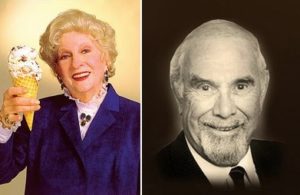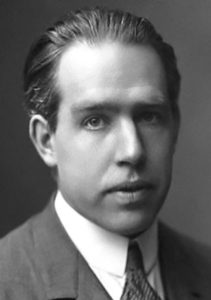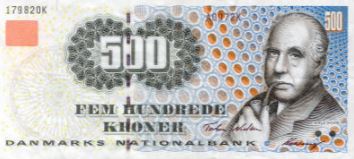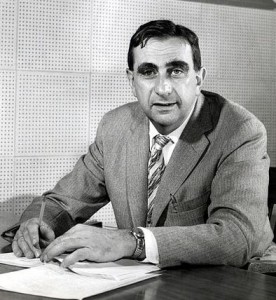
Rose and Reuben Mattus
Reuben Mattus (1912-1994) was born in Poland during World War I, which took his father’s life. He and his mother moved to New York when he was still a child. To make a living, the two worked at an ice cream parlour run by Mattus’ uncle, where ten-year old Reuben would squeeze lemons. By the time he finished high school, the family business was making chocolate ice cream bars and ice cream sandwiches, and sold them from a horse-drawn carriage. They opened up an ice cream factory in Brooklyn, where a young Rose Vesel (1916-2006) was hired to be a bookkeeper. Rose also immigrated with her Polish-Jewish family to New York as a five-year old. She first met Reuben on the streets of Brooklyn, and the two finally married in 1936. Two decades later, the couple decided to open up a new ice cream company. This ice cream would be richer and thicker, made with natural ingredients and butterfat as opposed to the artificial ingredients commonly used by other ice cream makers at the time. Since foreign-sounding names typically market better, Reuben came up with the Danish-sounding “Häagen-Dazs”, and put a map of Denmark on the logo. He did this as a tribute to Denmark, a country which strove to protect its Jews during the Holocaust. (The name “Häagen-Dazs” doesn’t actually mean anything in Danish!) While Reuben developed the recipes, Rose would sell the ice cream – initially by giving out free samples at supermarkets and universities, then catering to upscale restaurants. By 1973, Häagen-Dazs was the only ice cream being sold across the US, and opened its first official store just three years later. The Mattus’ sold the company for $70 million in 1983, but stayed on as consultants. Today, Häagen-Dazs is among the best-known ice cream brands in the world, and continues to operate ice cream shops all over the globe. (It still uses natural flavours and avoids using emulsifiers and artificial stabilizers like guar gum and carrageenan.) Reuben and Rose Mattus have been called the “Emperors of Ice Cream”, much like their fellow Jewish compatriots Baskin & Robbins and Ben & Jerry. Aside from ice cream, the Mattus’ were noted philanthropists, and strong supporters of Israel. They founded a school in Herzliya which still bears their name, and funded the construction of multiple settlements. They also financially supported the controversial Rabbi Meir Kahane, founder of the Jewish Defense League (JDL), as well as the Likud party. Rose Mattus sat on the board of the Zionist Organizations of America, and was reportedly a good friend of both Ariel Sharon and Benjamin Netanyahu. In 2004, she published a book detailing the incredible story of Häagen-Dazs.
Words of the Week
It is better to have an Israel that everyone hates, than an Auschwitz that everyone loves.
– Rabbi Meir Kahane

 Niels Henrik David Bohr (1885-1962) was born in Copenhagen. His mother was from a prominent Jewish-Danish family, and he was partly named after his grandfather, David Baruch Adler, an influential banker and parliamentarian. Bohr’s father was a famous physiology professor, who rejected his Lutheran roots in favour of atheism. (Bohr himself would later renounce any association with the Church of Denmark.) At 20, Bohr won a gold medal from the Royal Danish Academy of Sciences for his work on water viscosity and surface tension. He went on to earn a Master’s in mathematics and a Ph.D in physics. Bohr combined Rutherford’s ideas on the atom with Planck’s quantum theories to produce a revolutionary new atomic model, known as the Bohr model. This model finally made sense of the mysterious properties of atoms, and solved a major hurdle that baffled scientists for over 30 years. The discovery would earn Bohr a Nobel Prize in Physics. By 1917, Bohr was the Chair of Theoretical Physics at the University of Copenhagen, and sought to establish a new centre for physics research. Bohr got the government on board, and after receiving large donations from wealthy Danish Jews (together with the Carlsberg brewery), founded the Institute of Theoretical Physics – now known as the Niels Bohr Institute. There, his students discovered the 72nd element of the Periodic Table – whose existence Bohr had proposed – and named it Hafnium, the Latin name for Copenhagen. When the Nazis came to power, Bohr opened the doors of his institute to fleeing Jewish scientists. Denmark itself would soon be under Nazi control. In 1943, Bohr was informed that he would be arrested since, despite his mixed ancestry, he was considered a Jew according to the Nuremberg Laws. Bohr fled to Sweden, where he met with Swedish King Gustaf V to convince him to open Sweden’s doors to Jewish refugees. Bohr succeeded, and over 7000 Danish Jews were rescued and given asylum in Sweden. He then headed to England, where he assisted the war effort through the British “Tube Alloys” weapons project, before heading to the US to advise the Manhattan Project. Although he claimed his help was not needed to make the first nuclear bomb, others have admitted that he solved an important puzzle that made it happen. Bohr campaigned against the use of nuclear weapons for the rest of his life. It was his vision that resulted in the creation of the International Atomic Energy Agency, which monitors the use of nuclear power. Bohr went on to become the President of the Royal Danish Academy of Arts and Sciences. He chaired the Nordic Institute for Theoretical Physics, and played a central role in the founding of the world-famous CERN research organization. In addition to his monumental work in quantum physics, Bohr was a noted philosopher. Along with countless other awards, Bohr was bestowed the Order of the Elephant, the highest honour in Denmark (usually reserved only for royalty and heads of state), and is on the Danish 500-krone bill. He is one of just a handful of people who has an element on the Periodic Table named after him (bohrium).
Niels Henrik David Bohr (1885-1962) was born in Copenhagen. His mother was from a prominent Jewish-Danish family, and he was partly named after his grandfather, David Baruch Adler, an influential banker and parliamentarian. Bohr’s father was a famous physiology professor, who rejected his Lutheran roots in favour of atheism. (Bohr himself would later renounce any association with the Church of Denmark.) At 20, Bohr won a gold medal from the Royal Danish Academy of Sciences for his work on water viscosity and surface tension. He went on to earn a Master’s in mathematics and a Ph.D in physics. Bohr combined Rutherford’s ideas on the atom with Planck’s quantum theories to produce a revolutionary new atomic model, known as the Bohr model. This model finally made sense of the mysterious properties of atoms, and solved a major hurdle that baffled scientists for over 30 years. The discovery would earn Bohr a Nobel Prize in Physics. By 1917, Bohr was the Chair of Theoretical Physics at the University of Copenhagen, and sought to establish a new centre for physics research. Bohr got the government on board, and after receiving large donations from wealthy Danish Jews (together with the Carlsberg brewery), founded the Institute of Theoretical Physics – now known as the Niels Bohr Institute. There, his students discovered the 72nd element of the Periodic Table – whose existence Bohr had proposed – and named it Hafnium, the Latin name for Copenhagen. When the Nazis came to power, Bohr opened the doors of his institute to fleeing Jewish scientists. Denmark itself would soon be under Nazi control. In 1943, Bohr was informed that he would be arrested since, despite his mixed ancestry, he was considered a Jew according to the Nuremberg Laws. Bohr fled to Sweden, where he met with Swedish King Gustaf V to convince him to open Sweden’s doors to Jewish refugees. Bohr succeeded, and over 7000 Danish Jews were rescued and given asylum in Sweden. He then headed to England, where he assisted the war effort through the British “Tube Alloys” weapons project, before heading to the US to advise the Manhattan Project. Although he claimed his help was not needed to make the first nuclear bomb, others have admitted that he solved an important puzzle that made it happen. Bohr campaigned against the use of nuclear weapons for the rest of his life. It was his vision that resulted in the creation of the International Atomic Energy Agency, which monitors the use of nuclear power. Bohr went on to become the President of the Royal Danish Academy of Arts and Sciences. He chaired the Nordic Institute for Theoretical Physics, and played a central role in the founding of the world-famous CERN research organization. In addition to his monumental work in quantum physics, Bohr was a noted philosopher. Along with countless other awards, Bohr was bestowed the Order of the Elephant, the highest honour in Denmark (usually reserved only for royalty and heads of state), and is on the Danish 500-krone bill. He is one of just a handful of people who has an element on the Periodic Table named after him (bohrium).
